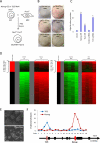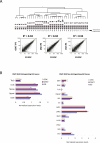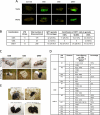Tbx3 improves the germ-line competency of induced pluripotent stem cells
- PMID: 20139965
- PMCID: PMC2901797
- DOI: 10.1038/nature08735
Tbx3 improves the germ-line competency of induced pluripotent stem cells
Abstract
Induced pluripotent stem (iPS) cells can be obtained by the introduction of defined factors into somatic cells. The combination of Oct4 (also known as Pou5f1), Sox2 and Klf4 (which we term OSK) constitutes the minimal requirement for generating iPS cells from mouse embryonic fibroblasts. These cells are thought to resemble embryonic stem cells (ESCs) on the basis of global gene expression analyses; however, few studies have tested the ability and efficiency of iPS cells to contribute to chimaerism, colonization of germ tissues, and most importantly, germ-line transmission and live birth from iPS cells produced by tetraploid complementation. Using genomic analyses of ESC genes that have roles in pluripotency and fusion-mediated somatic cell reprogramming, here we show that the transcription factor Tbx3 significantly improves the quality of iPS cells. iPS cells generated with OSK and Tbx3 (OSKT) are superior in both germ-cell contribution to the gonads and germ-line transmission frequency. However, global gene expression profiling could not distinguish between OSK and OSKT iPS cells. Genome-wide chromatin immunoprecipitation sequencing analysis of Tbx3-binding sites in ESCs suggests that Tbx3 regulates pluripotency-associated and reprogramming factors, in addition to sharing many common downstream regulatory targets with Oct4, Sox2, Nanog and Smad1. This study underscores the intrinsic qualitative differences between iPS cells generated by different methods, and highlights the need to rigorously characterize iPS cells beyond in vitro studies.
Figures




Similar articles
-
The timing of retroviral silencing correlates with the quality of induced pluripotent stem cell lines.Biochim Biophys Acta. 2011 Feb;1810(2):226-35. doi: 10.1016/j.bbagen.2010.10.004. Epub 2010 Oct 20. Biochim Biophys Acta. 2011. PMID: 20965232
-
Zic3 enhances the generation of mouse induced pluripotent stem cells.Stem Cells Dev. 2013 Jul 15;22(14):2017-25. doi: 10.1089/scd.2012.0651. Epub 2013 Mar 28. Stem Cells Dev. 2013. PMID: 23421367 Free PMC article.
-
Conversion of partially reprogrammed cells to fully pluripotent stem cells is associated with further activation of stem cell maintenance- and gamete generation-related genes.Stem Cells Dev. 2014 Nov 1;23(21):2637-48. doi: 10.1089/scd.2014.0020. Epub 2014 Aug 20. Stem Cells Dev. 2014. PMID: 24892478 Free PMC article.
-
[Induction and characterization of induced pluripotent stem (iPS) cells: a review].Sheng Wu Gong Cheng Xue Bao. 2010 Apr;26(4):421-30. Sheng Wu Gong Cheng Xue Bao. 2010. PMID: 20575428 Review. Chinese.
-
Generation of clinically relevant "induced pluripotent stem" (iPS) cells.J Stem Cells. 2011;6(3):109-27. J Stem Cells. 2011. PMID: 23264997 Review.
Cited by
-
TBX3 promotes human embryonic stem cell proliferation and neuroepithelial differentiation in a differentiation stage-dependent manner.Stem Cells. 2012 Oct;30(10):2152-63. doi: 10.1002/stem.1187. Stem Cells. 2012. PMID: 22865636 Free PMC article.
-
Regulation of organogenesis and stem cell properties by T-box transcription factors.Cell Mol Life Sci. 2013 Oct;70(20):3929-45. doi: 10.1007/s00018-013-1305-5. Epub 2013 Mar 12. Cell Mol Life Sci. 2013. PMID: 23479132 Free PMC article. Review.
-
Generation of transgene-free lung disease-specific human induced pluripotent stem cells using a single excisable lentiviral stem cell cassette.Stem Cells. 2010 Oct;28(10):1728-40. doi: 10.1002/stem.495. Stem Cells. 2010. PMID: 20715179 Free PMC article.
-
Large-scale quality analysis of published ChIP-seq data.G3 (Bethesda). 2014 Feb 19;4(2):209-23. doi: 10.1534/g3.113.008680. G3 (Bethesda). 2014. PMID: 24347632 Free PMC article.
-
Roles of the Polycomb group proteins in stem cells and cancer.Cell Death Dis. 2011 Sep 1;2(9):e204. doi: 10.1038/cddis.2011.84. Cell Death Dis. 2011. PMID: 21881606 Free PMC article. Review.
References
-
- Takahashi K, Yamanaka S. Induction of pluripotent stem cells from mouse embryonic and adult fibroblast cultures by defined factors. Cell. 2006;126:663–76. - PubMed
-
- Shi Y, et al. Induction of pluripotent stem cells from mouse embryonic fibroblasts by Oct4 and Klf4 with small-molecule compounds. Cell Stem Cell. 2008;3:568–74. - PubMed
-
- Okita K, Nakagawa M, Hyenjong H, Ichisaka T, Yamanaka S. Generation of mouse induced pluripotent stem cells without viral vectors. Science. 2008;322:949–53. - PubMed
Publication types
MeSH terms
Substances
Associated data
- Actions
- Actions
Grants and funding
LinkOut - more resources
Full Text Sources
Other Literature Sources
Molecular Biology Databases
Research Materials

